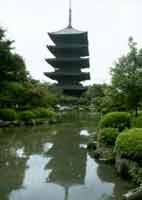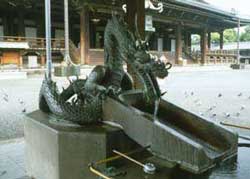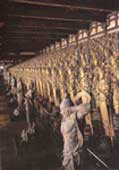Kyoto
| Kyoto Station Area | Central Kyoto | Eastern Kyoto | North-Eastern Kyoto | North-Western Kyoto |
|
When most people think Japan they think of Tokyo, the capital and one of the world's largest cities, so why did I want to visit Kyoto instead? Kyoto was Japan's capital for over a 1000 years until the capital was moved to Tokyo in 1868 which means it's the more historic city. Kyoto possesses the largest concentration of cultural properties in Japan, 17 sites are on the World Heritage List. Built in A.D. 794 on the model of the capitals of ancient China, Kyoto was the imperial capital of Japan from its foundation until the middle of the 19th century. As the centre of Japanese culture for more than 1,000 years, Kyoto illustrates the development of Japanese wooden architecture, particularly religious architecture, and the art of Japanese gardens, which has influenced landscape gardening the world over. It was also the largest city not bombed by the Americans during World War 2, although apparently it was on the short list for an atomic bomb. By war's end most Japanese cities had been reduced to rumble and there were few targets left. |
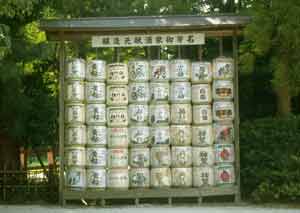 |
|
Why was Kyoto spared? With few targets left and over a million people Kyoto would have been a prime target. Most people, including the Japanese, credit American scholar Langdon Warner who sat on a committee during the latter half of the war which endeavoured to save artistic and historical treasures in war-torn regions. The Japanese government gave him the Order of the Sacred Treasure. Another theory to explain why Kyoto was spared was that it was an US intelligence public relations stunt to quell anti-American sentiment in post war occupied Japan. Over 50 years later a lesson not learned as American troops sat by and did nothing while the Baghdad Museum was being looted. Kyoto Station AreaKyoto Station will probably be your first site you see when you arrive in Kyoto. Although there is a small regional airport near Kyoto, most international visitors arrive at Kansai International Airport near Osaka then travel via train to Kyoto, there is a train terminal at the airport terminal. You will also notice several statues of anime characters at several of the stations entrances. Kyoto Station is HUGE, the largest in Japan. With three levels for trains, attached hotels, a nine story department store, a bus terminal, food courts, a tourist office it can be kind of overwhelming, especially after spending 20+ hours on airplanes. Although the tourist office is small the staff is very friendly, a staff member gave us three maps with marked routes to our Ryokan. In fact the staff at all the train stations I travelled through were friendly. Near Kyoto Station is Kyoto Tower, a 131 metre structure that supposedly represents a forever burning candle. Most people cite the construction of this building in 1964 as the beginning of the end to Kyoto's
traditional skyline.
There are several significant sites near Kyoto Station, in fact you might see the 57 metre tower of the Gojū-no-tō pagoda from the airport train as you enter the station, it is the tallest in Japan. The pagoda is part of the Tō-ji temple complex originally established in 794. The lecture hall (kōdō) and main (kondō) hall contain many statues.
Also near Kyoto Station is Nishi Hongan-ji temple, the world headquarters of the Hongan-ji branch of Jodo Shin-shu which has over 10,000 temples and 12 million followers worldwide. Many of the buildings date from 1591, unfortunately the main building is presently being restored and will be covered up until 2010. Two blocks east is Higashi Hongan-ji which in 1602 split from Jōdo Shin-shu and is now the headquarters of the Otani branch of Jodo Shin-shu. Although less impressive artistically than the Nishi buildings, the buildings are monumental in size including a 27 metre two story gateway and the founders hall which is one of the worlds largest wooden structures, standing 38m high, 76m long and 58m wide. Most of the temples also have a small stone basin with flowing water inside a pavilion to wash your hands and rinse your mouth before prayers. Use the bamboo ladles provided. Some of these pavilions can be very elaborate. Another block east are the Shosei-en gardens which were completed in 1657. Apparently not the most impressive garden in Kyoto but admission is free and a nice escape from the industrial look of the city near Kyoto Station. There are many branches of Buddhism which was introduced from China via Korea in the 6th century. The Japanese rationalised the coexistence of Buddhism with Shintō by considering Buddha to be a deity from China. Shintō gods are enshrined in Buddhist temples as protectors of the Buddha and Buddhist statues are included on Shintō altars. Central Kyoto AreaThe area called the central district is based on the area that was enclosed around a 16th century defensive wall. This area includes the main business area with office buildings, department stores, banks, restaurants etc and resembles any other Japanese city but it does contain several major sites.First build in 794, the Imperial Palace has being rebuild many times after destruction by fires. The present buildings date from 1855 and ceremonies related to enthronement and other state functions are still held here. Some Kyoto citizens think that as long as the Imperial Palace is maintained the royal family will someday return to Kyoto. To tour the grounds you need to make a reservations which is a lot easier for foreigners than locals, often the same day. We showed up about 5 minutes before the English tour was to begin, tours are at 10am and 2pm. While on your tour you will see the main ceremonial hall (Shishin-den) with the throne where the emperor sits for formal occasions. You will also see the small palace (Ko Gosho), the regular palace (Tsune Gosho) and a pond garden (Oike-niwa). Unfortunately you are forbidden to enter any of the buildings. 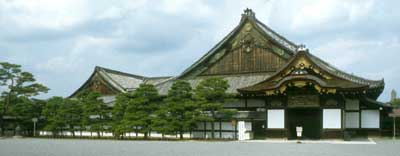
Also in Central Kyoto is Nijō-jō, one of the few remaining castles in Kyoto. Surrounded by two moats this residence contains two palaces and a vast garden. It built in 1603 for the Shogun Tokugawa Ieyasu and is fitted with 'nightingale' floors and concealed chambers. Any fan of ninja movies will recognise the features, its pretty funny to hear the squeaking of the floor boards when a crowd of people walk down the hall. If you've being to many castles or churches in Europe you notice a lack of furniture in most castles and temples. The floors are covered in mats and walls tend to be painted paper. Eastern Kyoto AreaThis area of Kyoto is between the Kamo-gawa river and the Higashiyama eastern hills and includes the Gion entertainment district where you might catch a glimpse of a geisha. The Kyoto National Museum, one of three in the country, is worth a visit. There are over 1000 artworks, historical artifacts and handicrafts including 230 items classified as National Treasures or Important Cultural
Properties.
Across the street from the museum is Sanjusangen-do temple, originally builted in 1164 and
rebuilt in 1266 after the original burned down. The temples name refers to the 33 bays (sanjusan) between the pillars of this long narrow building. The building houses 1001 wooden statues of Kannon (the Buddhist goddess of mercy), the first one carved in 1254. At the back of the hall are 28 guardian statues. An impressive sight.
Kiyomizu-dera temple was first built in 798, the present buildings are reconstructions dating from 1633. This temple is one of the more famous in Kyoto which means its usually swamped by hordes of Japanese tourists. You have to walk pass endless stalls and shops selling good luck charms, fortunes and all manners of souvenirs (I picked up a t-shirt) to get to the temple. The main hall has a huge veranda which juts over the hillside, supported by 139 15m- high wooden pillars. Its an excellent view of the city. There are several other buildings on the grounds including several pagoda and a sacred waterfall which improves health and test scores. Another popular temple is Ginkaku-ji, sometimes called the Silver Pavilion although the scheme to cover the building in silver leaf never happened. Build in 1482 as a villa for shogun Ashikaga Yoshimasa it was converted to a temple after his death. The gardens were laid out by painter and garden designer Soami and includes a stone garden which represents waves and Mt. Fuji. North-Eastern Kyoto AreaThis area of Kyoto contains some of Kyoto's modern architecture with boutiques, chic restaurants, and galleries. Between the Kamo-gawa and Takano-gawa rivers there is also some Shinto shrines and the city's Botanical Gardens. Shintō is the indigenous religion of Japan and is based on respect and awe of natural phenomena. It encompasses myths of the origin of Japan and the Japanese people including the royal family who were believed to be divine until 1945 when the Americans dismantled the mechanisms of State Shintō and forced the emperor to refute his divine status. In fact the Japanese believe their entire race is descended from the gods, a belief most every other religion and/or people seem to share.
Kamigamo-jinja is one of Japan's oldest shrines and predates the founding of Kyoto. The shrine was established in 679 and is dedicated to Raijin, the god of thunder. The present buildings, over 40 in all, including Haiden hall, are exact reproductions of the originals, dating from the 17th to 19th century. The shrine is entered from a long approach through two torii. At the fork of the Kamo-gawa and Takano-gawa is Shimogamo-jinja which dates from the 8th century and is dedicated to the god of the harvest. The hondo dates from 1863 and like Haiden hall at its sister shrine, Kamigamo-jinja, is an excellent example of nagare style shrine architecture. |
|
North-Western Kyoto Area
 This area of Kyoto is predominantly residential but there are numerous temples with tranquil gardens.
This area of Kyoto is predominantly residential but there are numerous temples with tranquil gardens.
The famed 'Golden Temple' or Kinkaku-ji is one of Japan's best-known sights. Originally built in 1397 as a retirement villa for shogun Ashikaga Yoshimitsu it was converted into a temple by his son. The three story pavilion is covered in gold leaf but was burned to the ground in 1950 by an obsessive monk. In 1955 it was fully reconstructed following exactly the original design, except the gold foil cover was extended to the lower levels. Its an extremely photogenic temple so expect plenty of crowds.
For people interested in Zen there is an area containing several Zen temples in a large park setting in a residential neighbourhood. The Imamiya-jinja shrine is also near, the
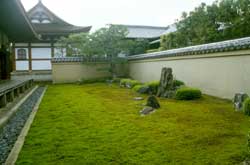 torii spans a residential street. Within the temple district are 24 subtemples, but only 8
are open to the public, this is the place to visit for an intense look at Zen culture. I enjoyed the Zen gardens at Ryogen-in temple founded in 1502. An inner rock garden, Totekiko, is the smallest in Japan while I enjoyed the moss garden, Ryugintei.
torii spans a residential street. Within the temple district are 24 subtemples, but only 8
are open to the public, this is the place to visit for an intense look at Zen culture. I enjoyed the Zen gardens at Ryogen-in temple founded in 1502. An inner rock garden, Totekiko, is the smallest in Japan while I enjoyed the moss garden, Ryugintei.
Final Thoughts
The above passages just briefly describes the sights I saw while visiting Kyoto, there are more sights, with 17 on the World Heritage List, even more considered Important Cultural Treasures and most temples and shrines having Treasures Halls there is plenty to keep you busy in Kyoto for a while although you will eventually suffer from temple overload.
The transportation system is efficient and fast. If you don't have a Japanese rail pass, treat yourself to a ride on the bullet train. If you have a pass only ride the bullet trains, very impressive.
There are vending machines everywhere, its a shock to walk 50 metres and not see some sort of vending machine. You can purchase almost anything from a vending machine.
Although Kyoto is not as expensive as Tokyo, Japan is a first world nation with a high standard of living so it is one of the more expensive countries to visit. To save some money and to get a more unique Japanese experience I would recommend staying in a Ryokan or traditional Japanese Inn, a number of them are very accepting of gaijin. Don't worry too much if you are unilingual English, there are plenty of English signage. Announcements on trains are often bilingual and a lot of restaurants have English menus. The restaurants without English menus often have pictures or models of the dishes, just point. Many stores, including at the train stations, sell boxed lunches, another way to save some money. And noodles are always cheap. About the only thing I saw that was cheaper than home was cigarettes.
Japan is also probably one of the safest countries in the world. I noticed one jay walker in over a week in Japan. Many people get around Kyoto by bike and I noticed many left unlocked. You are more likely to lose your money than to have it stolen. Safe,
polite but expensive.
| Visit the Kansai Area |
Visit Hiroshima |
Return to Travel Page |
Return to Main Page |
